Soil Amendment-Mediated Herbivory Resistance, Crop Improvement, and Phytoremediation in Canola: Physiological Defense Mechanism and Health Risk Assessment
Abstract
1. Introduction
2. Results
2.1. Abundance of Aphids
2.2. Yield Attributes of Canola
2.3. Nutrient Defense Responses
2.4. Phytoremediation of Cu and Zn
2.5. Phenolic Defense Responses
2.6. Health Risk Assessment for Humans
3. Discussion
3.1. Effect of SAT on Aphid Abundance
3.2. Effect of SAT on Yield Attributes
3.3. Effect of SAT on Phytoremediation
3.4. Effect of SAT on Nutrient Defense
3.5. Effect of SAT on Phenolic Defense
3.6. Effect of SAT on Human Health Risk
4. Materials and Methods
4.1. Features of the Experimental Area
4.2. Physical and Biochemical Properties of the Soil
4.3. Sowing of Canola and Field Management Practices
4.4. Application of SAT in the Soil
4.5. Abundance of Aphids in the Field
4.6. Yield Attributes of Canola
4.7. Nutrient Mechanism of Defense
4.7.1. Nitrogen
4.7.2. Phosphorus
4.7.3. Potassium
4.7.4. Sulfur
4.7.5. Mg, Fe, Ca, Cu, and Zn
4.8. Phenolic Mechanism of Defense (RP-HPLC)
4.9. Health Risk Assessment for Humans
4.10. Statistical Analyses
5. Conclusions
Author Contributions
Funding
Data Availability Statement
Acknowledgments
Conflicts of Interest
References
- Swain, C.K. Environmental pollution indices: A review on concentration of heavy metals in air, water, and soil near industrialization and urbanisation. Discov. Environ. 2024, 2, 5. [Google Scholar]
- Rathod, S.V.; Saras, P.; Gondaliya, S.M. Environmental pollution: Threats and challenges for management. In Eco-Restoration of Polluted Environment, 1st ed.; Rathod, S.V., Ed.; CRC Press: London, UK, 2024; p. 34. [Google Scholar]
- Poornima, S.; Dadi, M.; Subash, S.; Manikandan, S.; Karthik, V.; Deena, S.R.; Balachandar, R.; Kumaran, S.K.N.; Subbaiya, R. Review on advances in toxic pollutants remediation by solid waste composting and vermicomposting. Sci. Afr. 2024, 23, e02100. [Google Scholar]
- Rodriguez-Eugenio, N.; McLaughlin, M.; Pennock, D. Soil Pollution: A Hidden Reality; FAO—Food and Agriculture Organization of the United Nations: Rome, Italy, 2018. [Google Scholar]
- Sundrum, A. Beneficial and Harmful Effects of Agricultural Industrialization. In Public Welfare-Oriented Production of Food: Substantially New Impulses for a Sustainable Agro-Food Sector; Springer: Berlin/Heidelberg, Germany, 2024; pp. 121–166. [Google Scholar]
- Nasab, R.S.; Yali, M.P.; Bozorg-Amirkalaee, M. Effects of humic acid and plant growth-promoting rhizobacteria (PGPR) on induced resistance of canola to Brevicoryne brassicae L. Bull. Entomol. Res. 2019, 109, 479–489. [Google Scholar]
- Javed, M.W.; Hasan, M.U.; Sagheer, M.; Sahi, S.T. Studies on inducer mediated resistance responses against biological fitness of Brevicoryne brassicae (Homoptera: Aphididae) on Brassica napus. Int. J. Agric. Biol. 2021, 25, 81–88. [Google Scholar]
- Mohamed, I.A.A.; Shahby, N.; Bai, C.; Qin, M.; Agami, R.A.; Jie, K.; Wang, B.; Zhou, G. Stomatal and photosynthetic traits are associated with investigating sodium chloride tolerance of Brassica napus L. cultivars. Plants 2020, 9, 62. [Google Scholar] [CrossRef]
- Javed, M.W.; Hasan, M.U.; Sagheer, M.; Sahi, S.T.; Mankin, R.W. Foliar and soil treatments of Brassica napus that elicit antibiosis in Brevicoryne brassicae. Agronomy 2022, 12, 882. [Google Scholar] [CrossRef]
- Razaq, M.; Mehmood, A.; Aslam, M.; Ismail, M.; Afzal, M.; Shad, S.A. Losses in yield and yield components caused by aphids to late sown Brassica napus L., Brassica juncea L. and Brassica carrinata A. Braun at Multan, Punjab (Pakistan). Pak. J. Bot. 2011, 43, 319–324. [Google Scholar]
- Mosavi, S.S.; Zare, E.N.; Behniafar, H.; Nezhad, S.M.; Neisiany, R.E. Remediation of acetamiprid pesticide from contaminated water by antibacterial biosorbent based on carboxymethyl tragacanth-grafted-poly (3-aminophenol) decorated with ZnO@ Fe3O4. Environ. Res. 2024, 252, 118893. [Google Scholar] [CrossRef]
- Du, L.; Gao, X.; Zhao, L.; Zhu, X.; Wang, L.; Zhang, K.; Li, D.; Ji, J.; Luo, J.; Cui, J. Assessment of the risk of imidaclothiz to the dominant aphid parasitoid Binodoxys communis (Hymenoptera: Braconidae). Environ. Res. 2023, 238, 117165. [Google Scholar] [CrossRef] [PubMed]
- Ajermoun, N.; Aghris, S.; Ettadili, F.; Alaoui, O.T.; Laghrib, F.; Farahi, A.; Lahrich, S.; Bakasse, M.; Saqrane, S.; El Mhammedi, M.A. Phytotoxic effect of the insecticide imidacloprid in Phaseolus vulgaris L. plant and evaluation of its bioaccumulation and translocation by electrochemical methods. Environ. Res. 2022, 214, 113794. [Google Scholar]
- Devendar, P.; Yang, G.F. Sulfur-Containing Agrochemicals. Top Curr. Chem. 2017, 375, 82. [Google Scholar] [CrossRef]
- Parchem, K.; Piekarska, A.; Bartoszek, A. Enzymatic activities behind degradation of glucosinolates. In Glucosinolates: Properties, Recovery, and Applications; Galanakis, C.M., Ed.; Academic Press: New York, NY, USA, 2019; pp. 79–106. [Google Scholar]
- Tacoli, F.; Cargnus, E.; Zandigiacomo, P.; Pavan, F. Side effects of sulfur dust on the European grapevine moth Lobesia botrana and the predatory mite Kampimodromus aberrans in vineyards. Insects 2020, 11, 825. [Google Scholar] [CrossRef] [PubMed]
- Zappala, L.; Siscaro, G.; Biondi, A.; Molla, O.; Gonzalez-Cabrera, J.; Urbaneja, A. Efficacy of sulphur on Tuta absoluta and its side effects on the predator Nesidiocoris tenuis. J. Appl. Entomol. 2012, 136, 401–409. [Google Scholar] [CrossRef]
- Getnet, M.; Raja, N. Impact of vermicompost on growth and development of cabbage, Brassica oleracea Linn. and their sucking pest, Brevicoryne brassicae Linn.(Homoptera: Aphididae). Res. J. Environ. Earth Sci. 2013, 5, 104–112. [Google Scholar] [CrossRef]
- Sienkiewicz-Cholewa, U.; Kieloch, R. Effect of sulphur and micronutrients fertilization on yield and fat content in winter rape seeds (Brassica napus L.). Plant Soil Environ. 2015, 61, 164–170. [Google Scholar] [CrossRef]
- Abdallah, M.; Dubousset, L.; Meuriot, F.; Etienne, P.; Avice, J.C.; Ourry, A. Effect of mineral sulphur availability on nitrogen and sulphur uptake and remobilization during the vegetative growth of Brassica napus L. J. Exp. Bot. 2010, 61, 2635–2646. [Google Scholar] [CrossRef] [PubMed]
- Ribas-Agusti, A.; Seda, M.; Sarraga, C.; Montero, J.I.; Castellari, M.; Munoz, P. Municipal solid waste composting: Application as a tomato fertilizer and its effect on crop yield, fruit quality and phenolic content. Renew. Agric. Food Syst. 2017, 32, 358–365. [Google Scholar] [CrossRef]
- Bharose, R.; Chandra, S.; Thomas, T.; Dhan, D. Effect of different levels of phosphorus and sulphur on yield and availability of NPK, protein and oil content in Toria (Brassica sp.) Var. PT–303. J. Agric. Biol. Sci. 2011, 6, 31–33. [Google Scholar]
- Kazemeini, S.A.; Hamzehzarghani, H.; Edalat, M. The impact of nitrogen and organic matter on winter canola seed yield and yield components. Aust. J. Crop Sci. 2010, 4, 335–342. [Google Scholar]
- Li, J.; Zhu, Z.; Guo, S. Effects of nitrogen and sulfur application on antioxidant substances in leaf mustard. Acta Hortic. 2010, 856, 83–90. [Google Scholar] [CrossRef]
- Saini, N.; Anmol, A.; Kumar, S.; Wani, A.W.; Bakshi, M.; Dhiman, Z. Exploring phenolic compounds as natural stress alleviators in plants-a comprehensive review. Physiol. Mol. Plant Pathol. 2024, 133, 102383. [Google Scholar] [CrossRef]
- Pratyusha, S. Phenolic Compounds in the Plant Development and Defense: An Overview. In Plant Stress Physiology: Perspectives in Agriculture; Hasanuzzaman, M., Nahar, K., Eds.; IntechOpen: London, UK, 2022; pp. 125–140. [Google Scholar]
- Singh, S.; Kaur, I.; Kariyat, R. The Multifunctional Roles of Polyphenols in Plant-Herbivore Interactions. Int. J. Mol. Sci. 2021, 22, 1442. [Google Scholar] [CrossRef]
- Ur Rehman, H.; Iqbal, Q.; Farooq, M.; Wahid, A.; Afzal, I.; Basra, S.M.A. Sulphur application improves the growth, seed yield and oil quality of canola. Acta Physiol. Plant. 2013, 35, 2999–3006. [Google Scholar] [CrossRef]
- Saxena, S.; Nainwal, R.C. Effect of Sulphur and Boron Nutrition on Yield, Yield Attributes and Economics of Soybean. Soybean Res. 2010, 8, 7–12. [Google Scholar]
- Shah, S.H.; Parrey, Z.A.; Islam, S.; Tyagi, A.; Ahmad, A.; Mohammad, F. Exogenously Applied Sulphur Improves Growth, Photosynthetic Efficiency, Enzymatic Activities, Mineral Nutrient Contents, Yield, and Quality of Brassica juncea L. Sustainability 2022, 14, 14441. [Google Scholar] [CrossRef]
- Rebouh, N.Y.; Khugaev, C.V.; Utkina, A.O.; Isaev, K.V.; Mohamed, E.S.; Kucher, D.E. Contribution of Eco-Friendly Agricultural Practices in Improving and Stabilizing Wheat Crop Yield: A Review. Agronomy 2023, 13, 2400. [Google Scholar] [CrossRef]
- Matraszek, R.; Hawrylak-Nowak, B.; Chwil, S.; Chwil, M. Macroelemental Composition of Cadmium-Stressed Lettuce Plants Grown under Conditions of Intensive Sulphur Nutrition. J. Environ. Manag. 2016, 180, 24–34. [Google Scholar]
- Mahmoud, Y.A.; Saleh, M.M.E.; Ebadah, I.M.A.; Moawad, S.S.; Abdel-Razek, A.S. Influence of organic soil fertilization on the population of two insect pests and the productivity of tomato plants in a plastic greenhouse. Pak. J. Life Soc. Sci. 2021, 19, 69–76. [Google Scholar]
- Ahouangninou, C.; Hounmalon, G.A.; Zandjanakou-Tachin, M.; Mensah, A.; Osse, R.; Tanmakpi, J.; Ntehoue, D.; Lougbegnon, T.; Kestemont, M.P.; Edorh, P.; et al. Effect of compost and association (Solanum + Amaranth) on pests and productivity of Solanum macrocarpon. Int. J. Agric. Biosci. 2022, 11, 251–255. [Google Scholar]
- Mehrparvar, M.; Mansouri, S.M.; Hatami, B. Some Bioecological Aspects of the Rose Aphid, Macrosiphum rosae (Hemiptera: Aphididae) and Its Natural Enemies. Acta Univ. Sapientiae Agric. Environ. 2016, 8, 74–88. [Google Scholar]
- Demir, I.; Basalma, D. Response of Different Levels of Nitrogen and Sulphur Doses on Oil Yield and Seed Nutrients Content of Sunflower (Helianthus annuus L.). Fresenius Environ. Bull. 2018, 27, 6337–6342. [Google Scholar]
- Asemoloye, M.D.; Chukwuka, K.S.; Jonathan, S.G. Spent Mushroom Compost Enhances Plant Response and Phytoremediation of Heavy Metal Polluted Soil. J. Plant Nutr. Soil Sci. 2020, 183, 492–499. [Google Scholar]
- Irfan, M.; Mudassir, M.; Khan, M.J.; Dawar, K.M.; Muhammad, D.; Mian, I.A.; Ali, W.; Fahad, S.; Saud, S.; Hayat, Z.; et al. Heavy metals immobilization and improvement in maize (Zea mays L.) growth amended with biochar and compost. Sci. Rep. 2021, 11, 18416. [Google Scholar]
- Sarathchandra, S.S.; Rengel, Z.; Solaiman, Z.M. Remediation of heavy metal-contaminated iron ore tailings by applying compost and growing perennial ryegrass (Lolium perenne L.). Chemosphere 2022, 288, 132573. [Google Scholar]
- Shi, G.; Lu, H.; Liu, H.; Lou, L.; Zhang, P.; Song, G.; Zhou, H.; Ma, H. Sulfate application decreases translocation of arsenic and cadmium within wheat (Triticum aestivum L.) plant. Sci. Total Environ. 2020, 713, 136665. [Google Scholar]
- Roy, N.; Ghosh, G.K. Enhancing nutrient availability, yield, and quality of safflower (Carthamus tinctorius L.) through zinc and sulphur in Alfisol. J. Pharmacogn. Phytochem. 2020, 9, 693–697. [Google Scholar]
- Ikoyi, I.; Fowler, A.; Storey, S.; Doyle, E.; Schmalenberger, A. Sulfate fertilization supports growth of ryegrass in soil columns but changes microbial community structures and reduces abundances of nematodes and arbuscular mycorrhiza. Sci. Total Environ. 2020, 704, 135315. [Google Scholar]
- Kumar, U.; Panneerselvam, P.; Gupta, V.V.S.R.; Manjunath, M.; Priyadarshinee, P.; Sahoo, A.; Dash, S.R.; Kaviraj, M.; Annapurna, K. Diversity of sulfur-oxidizing and sulfur-reducing microbes in diverse ecosystems. In Advances in Soil Microbiology: Recent Trends and Future Prospects; Adhya, T., Lal, B., Mohapatra, B., Paul, D., Das, S., Eds.; Microorganisms for Sustainability; Springer: Singapore, 2018; Volume 3, pp. 65–89. [Google Scholar]
- Li, H.; Pu, P.; Li, X.; Gong, Y.; An, D.; Zhang, L.; Lv, J. Sulfur application reduces cadmium uptake in edible parts of pakchoi (Brassica chinensis L.) by cadmium chelation and vacuolar sequestration. Ecotoxicol. Environ. Saf. 2020, 194, 110402. [Google Scholar] [PubMed]
- Tian, W.; Wilson, T.L.; Chen, G.; Guttieri, M.J.; Nelson, N.O.; Fritz, A.; Smith, G.; Li, Y. Effects of environment, nitrogen, and sulfur on total phenolic content and phenolic acid composition of winter wheat grain. Cereal Chem. 2021, 98, 903–911. [Google Scholar]
- Taie, H.A.; El-Mergawi, R.; Radwan, S. Isoflavonoids, flavonoids, phenolic acids profiles and antioxidant activity of soybean seeds as affected by organic and bioorganic fertilization. Am. Eurasian J. Agric. Environ. Sci. 2008, 4, 207–213. [Google Scholar]
- Ibrahim, H.A.K.; Balah, M.A.A. Study the use of compost tea in weed suppression. Int. J. Environ. Res. 2018, 12, 609–618. [Google Scholar]
- Wu, L.; Sung, Y.; Chen, J. Study of the inhibition of weed seed germination using tomato and melon residues fast compost. J. Taiwan Soc. Hortic. Sci. 2018, 64, 197–208. [Google Scholar]
- Lata, D.; Singh, A.; Kumar, R.; Patel, V.B.; Maurya, M.; Singh, R.K.; Singh, A. Effect of postharvest hydrogen sulphide on lignification and biochemical markers of pointed gourd. Plant Biol. 2022, 24, 704–710. [Google Scholar]
- PaltPaltseva, A.; Cheng, Z.; Deeb, M.; Groffman, P.M.; Shaw, R.K.; Maddaloni, M. Accumulation of arsenic and lead in garden-grown vegetables: Factors and mitigation strategies. Sci. Total Environ. 2018, 640, 273–283. [Google Scholar]
- Estefan, G.; Sommer, R.; Ryan, J. Methods of Soil, Plant, and Water Analysis: A Manual for the West Asia and North Africa Region, 3rd ed.; International Center for Agricultural Research in the Dry Areas (ICARDA): Beirut, Lebanon, 2013. [Google Scholar]
- Jiang, J.; Tu, J.; Fu, F.; Ecke, W.; Cheng, Y.; Guan, C.; Meng, J. Metabolic Characteristics in Meal of Black Rapeseed and Yellow-Seeded Progeny of Brassica napus–Sinapis alba Hybrids. Molecules 2015, 20, 21204–21213. [Google Scholar] [CrossRef] [PubMed]
- Abou Hussien, E.; Shalaby, M.; Alshahri, B. Utilizing Compost and Biochar in Enhancing Phytoremediation of Contaminated Soil. Menoufia J. Soil Sci. 2020, 5, 201–213. [Google Scholar]
- Jadia, C.D.; Fulekar, M.H. Phytoremediation: The application of vermicompost to remove zinc, cadmium, copper, nickel, and lead by sunflower plant. Environ. Eng. Manag. J. 2008, 7, 547–558. [Google Scholar]
- Lachica-Garrido, M. Determination of sulphur in plant material. Analyst 1964, 89, 61–66. [Google Scholar]
- Shao, Y.; Jiang, J.; Ran, L.; Lu, C.; Wei, C.; Wang, Y. Analysis of flavonoids and hydroxycinnamic acid derivatives in rapeseeds (Brassica napus L. var. napus) by HPLC-PDA–ESI(−)-MSn/HRMS. J. Agric. Food Chem. 2014, 62, 2935–2945. [Google Scholar]
- Papazi, A.; Karamanli, M.; Kotzabasis, K. Comparative biodegradation of all chlorinated phenols by the microalga Scenedesmus obliquus—The biodegradation strategy of microalgae. J. Biotechnol. 2019, 296, 61–68. [Google Scholar]
- Aguilar, M.; Mondaca, P.; Ginocchio, R.; Vidal, K.; Sauve, S.; Neaman, A. Comparison of exposure to trace elements through vegetable consumption between a mining area and an agricultural area in central Chile. Environ. Sci. Pollut. Res. 2018, 25, 19114–19121. [Google Scholar] [CrossRef] [PubMed]
- Barrio-Parra, F.; Izquierdo-Diaz, M.; Dominguez-Castillo, A.; Medina, R.; De Miguel, E. Human-health probabilistic risk assessment: The role of exposure factors in an urban garden scenario. Landsc. Urban Plan. 2019, 185, 191–199. [Google Scholar] [CrossRef]
- Glantz, S.A.; Slinker, B.K.; Neilands, T.B. Primer of Applied Regression and Analysis of Variance, 3rd ed.; McGraw-Hill Education: New York, NY, USA, 2016. [Google Scholar]
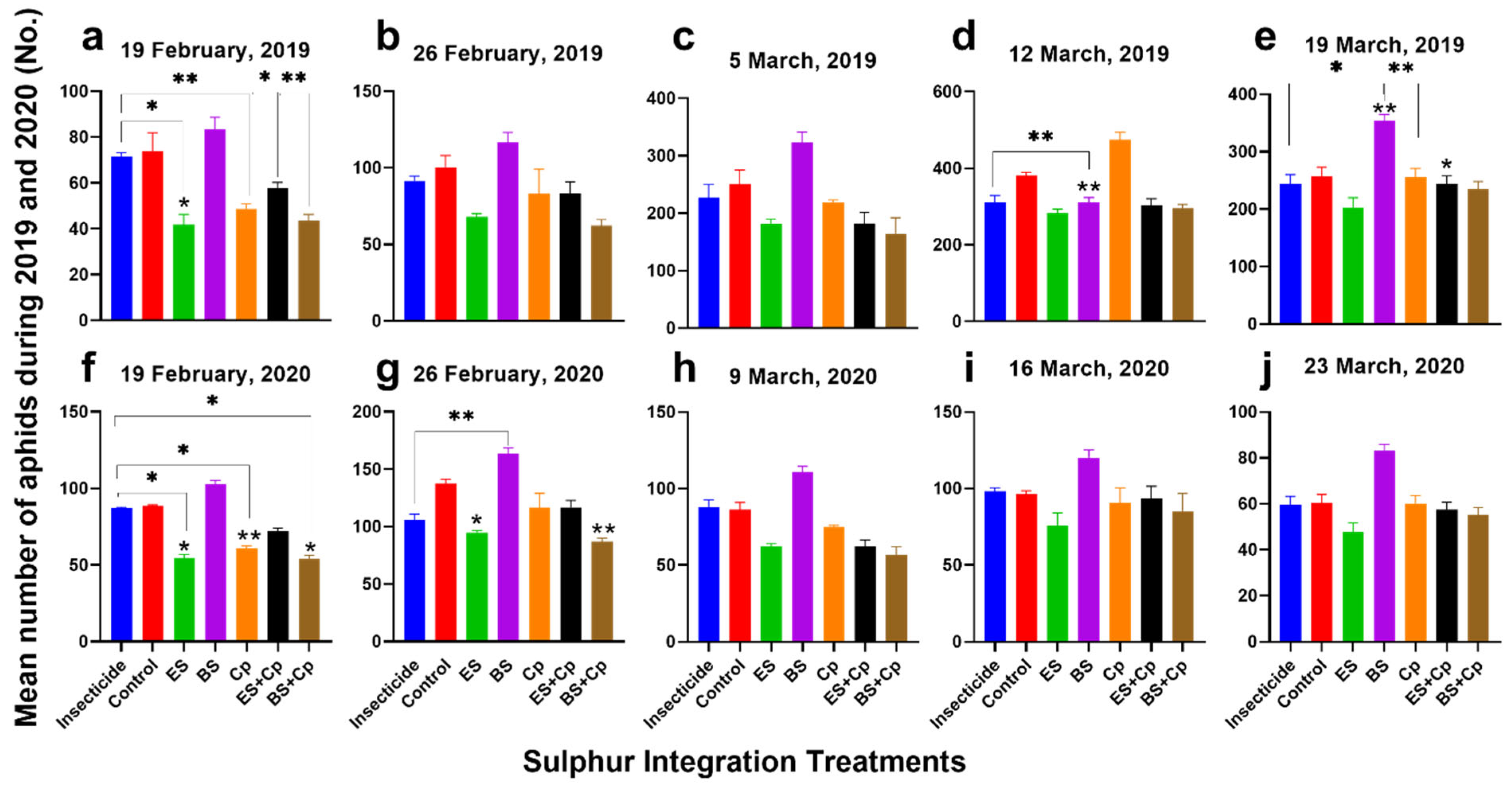
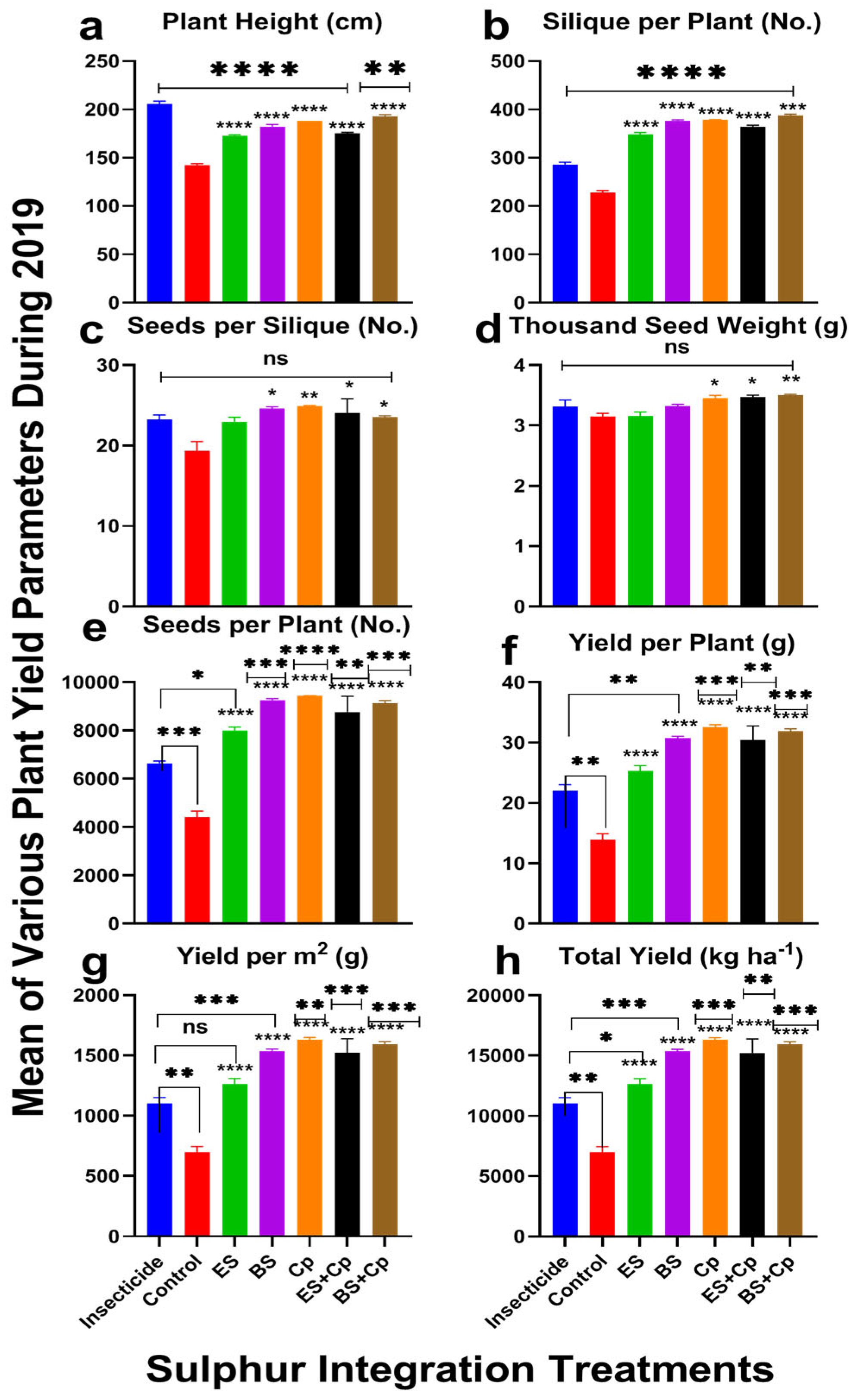

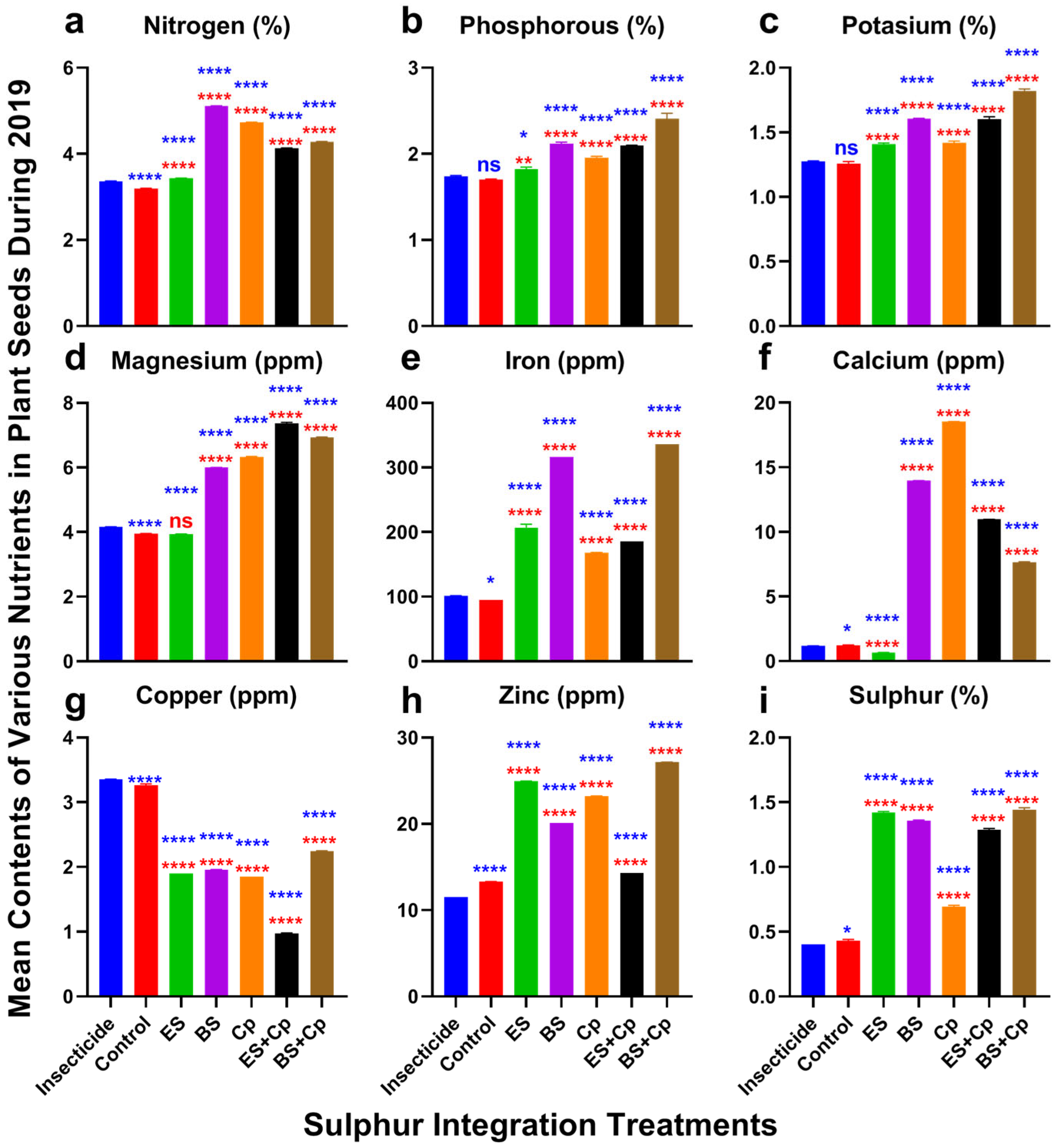
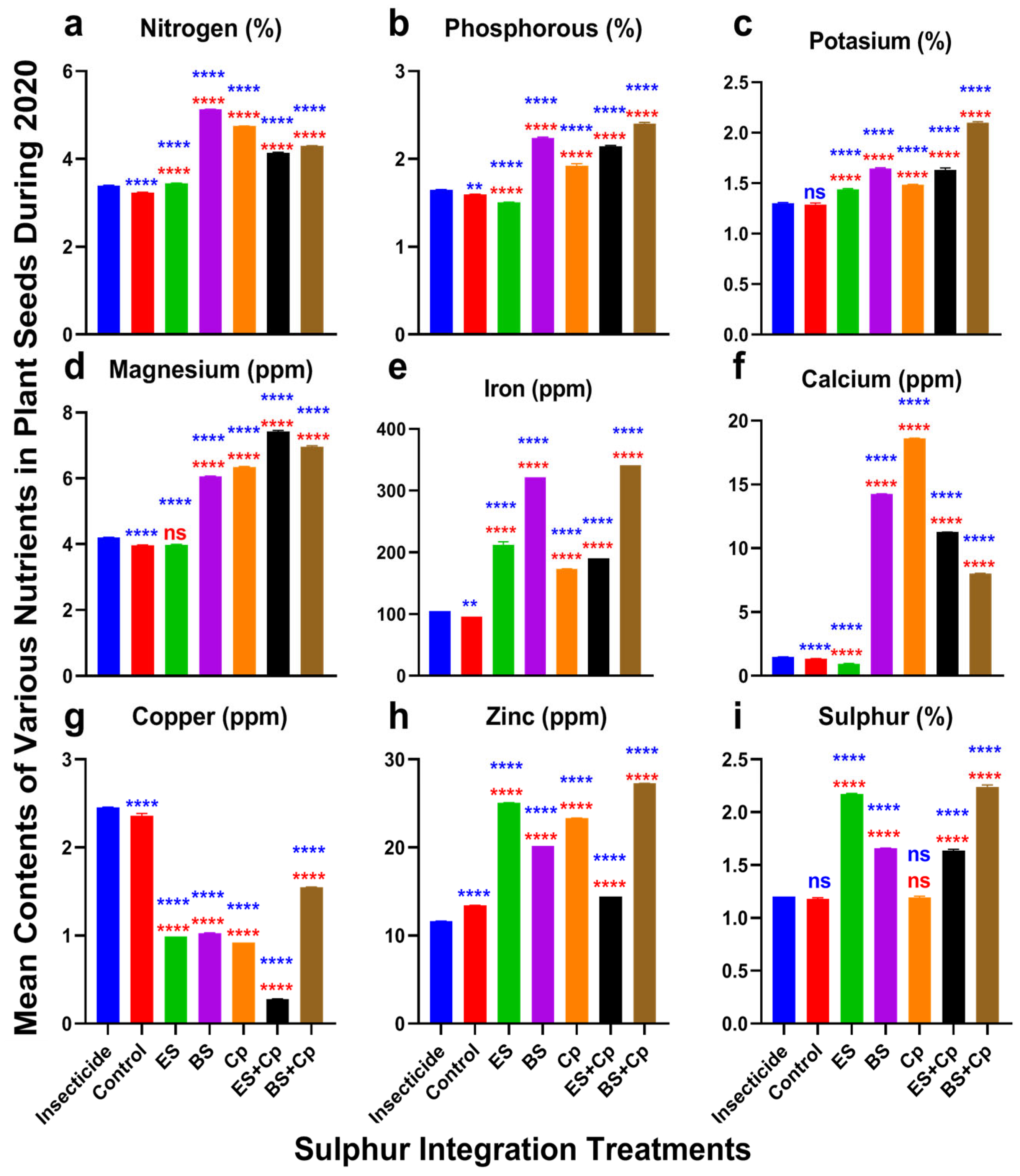
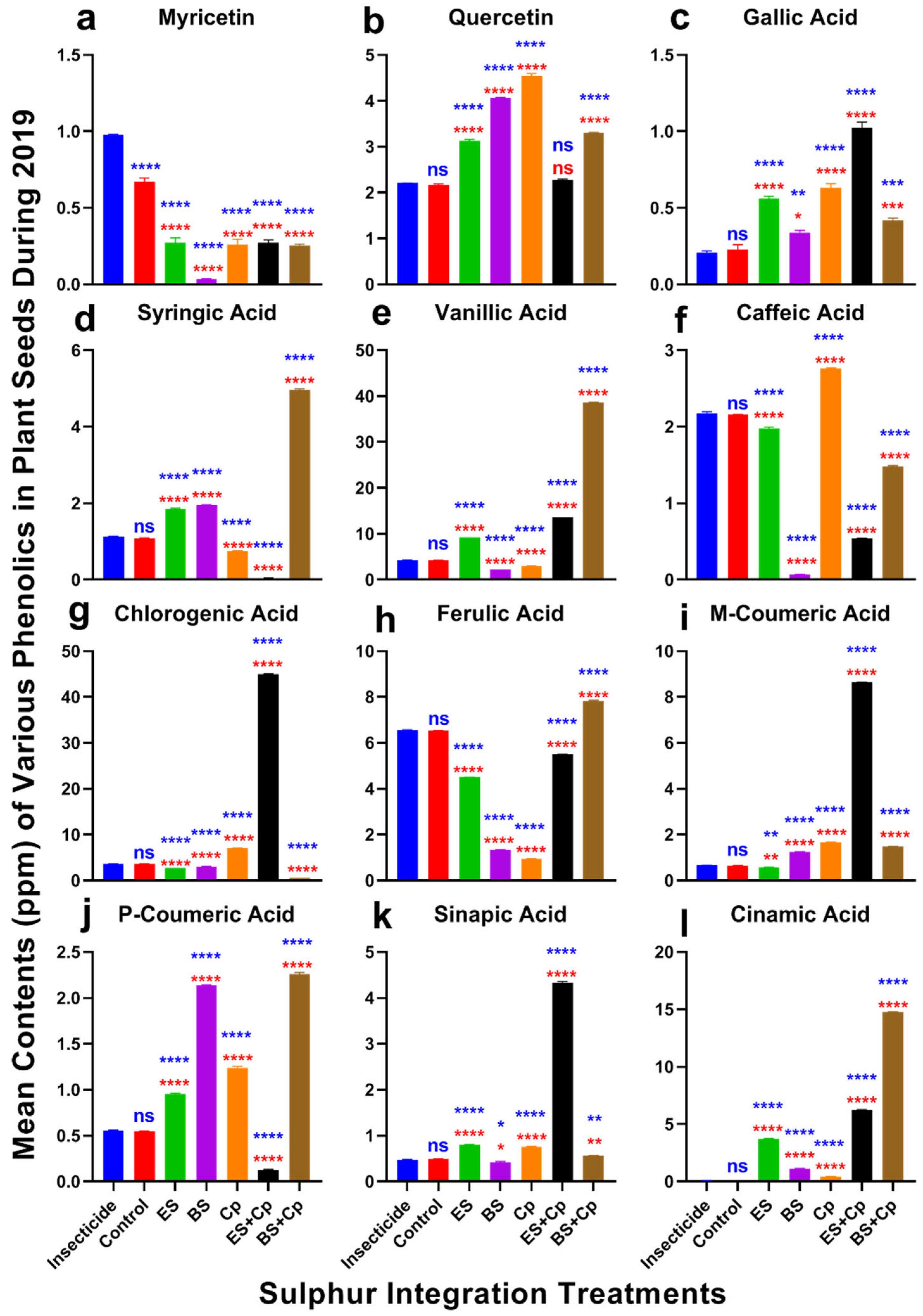
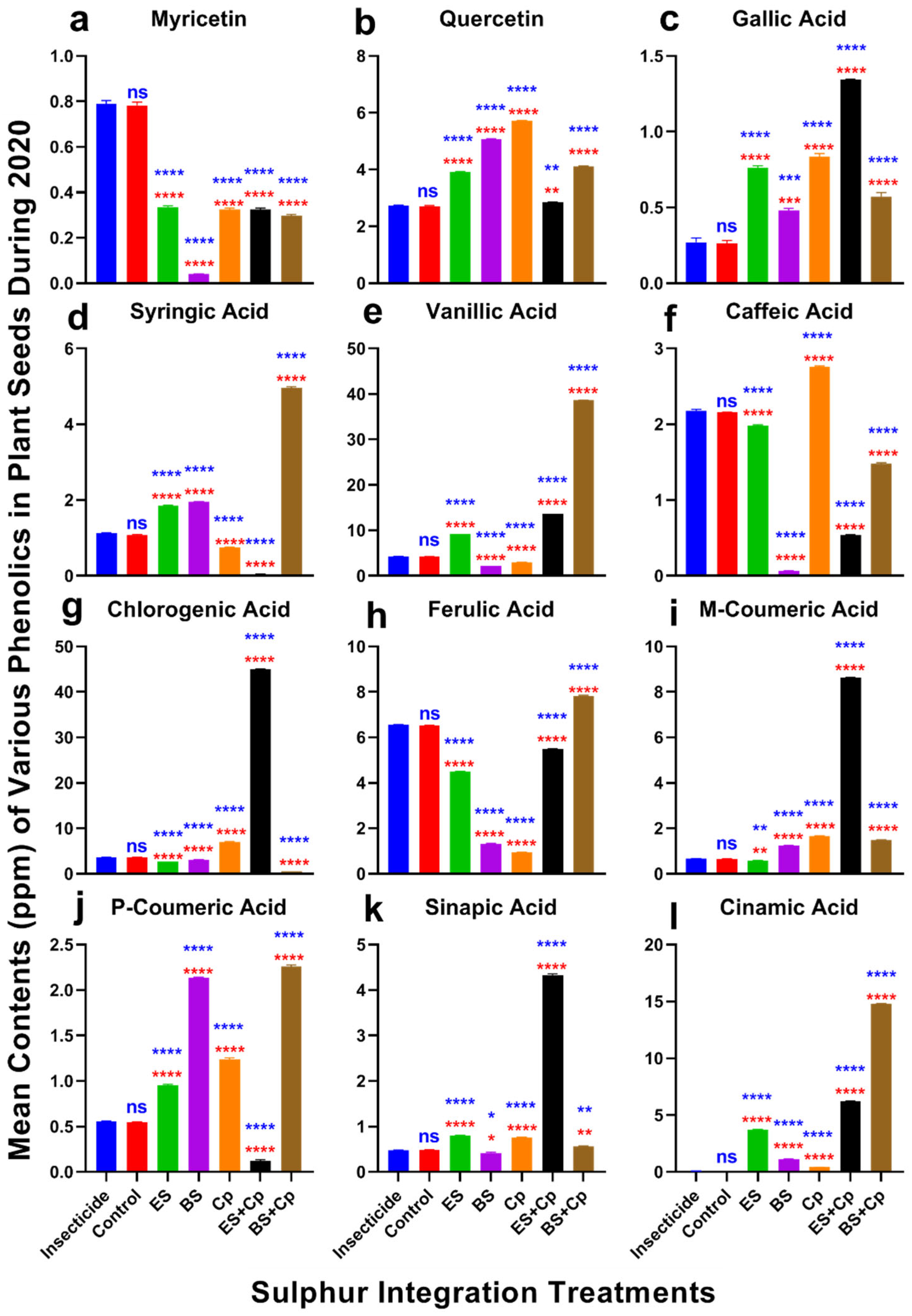
 with respect to untreated control (ns: p > 0.05, *: p < 0.05, **: p < 0.01, ***: p < 0.001, ****: p < 0.0001,
with respect to untreated control (ns: p > 0.05, *: p < 0.05, **: p < 0.01, ***: p < 0.001, ****: p < 0.0001,  : p < 0.05,
: p < 0.05,  : p < 0.01,
: p < 0.01,  : p < 0.001,
: p < 0.001,  : p < 0.0001).
: p < 0.0001).
 with respect to untreated control (ns: p > 0.05, *: p < 0.05, **: p < 0.01, ***: p < 0.001, ****: p < 0.0001,
with respect to untreated control (ns: p > 0.05, *: p < 0.05, **: p < 0.01, ***: p < 0.001, ****: p < 0.0001,  : p < 0.05,
: p < 0.05,  : p < 0.01,
: p < 0.01,  : p < 0.001,
: p < 0.001,  : p < 0.0001).
: p < 0.0001).| Nature of Treatments | Field Experiments of 2019 | Field Experiments of 2020 | ||
|---|---|---|---|---|
| Copper | Zinc | Copper | Zinc | |
| Insecticide | 0.00434 ± 0.0003 | 0.0176 ± 0.012 | 0.0056 ± 0.005 | 0.0211 ± 0.0011 |
| Control | 0.00433 ± 0.0003 (ns) | 0.0174 ± 0.012 (ns) | 0.0060 ± 0.005 (ns) | 0.0244 ± 0.0021 (ns) |
| ES | 0.00331 ± 0.0002 (*, ) ) | 0.0407 ± 0.041 (***, ) ) | 0.0022 ± 0.002 (**, ) ) | 0.0460 ± 0.0051 (***, ) ) |
| BS | 0.00337 ± 0.0002 (*, ) ) | 0.0332 ± 0.033 (**, ) ) | 0.0027 ± 0.002 (**, ) ) | 0.0369 ± 0.0031 (**, ) ) |
| Cp | 0.00335 ± 0.0002 (*, ) ) | 0.0390 ± 0.037 (**, ) ) | 0.0028 ± 0.002 (**, ) ) | 0.0448 ± 0.0043 (***, ) ) |
| ES+Cp | 0.00152 ± 0.0001 (***, ) ) | 0.0227 ± 0.028 (*, ) ) | 0.0012 ± 0.001 (**, ) ) | 0.0262 ± 0.002 (**, ) ) |
| BS+Cp | 0.00391 ± 0.0003 (ns,ns) | 0.0427 ± 0.051 (***, ) ) | 0.0032 ± 0.002 (*, ) ) | 0.0500 ± 0.0071 (****, ) ) |
 with respect to untreated control (ns: p > 0.05, *: p < 0.05, **: p < 0.01, ***: p < 0.001, ****: p < 0.0001,
with respect to untreated control (ns: p > 0.05, *: p < 0.05, **: p < 0.01, ***: p < 0.001, ****: p < 0.0001,  : p < 0.05,
: p < 0.05,  : p < 0.01,
: p < 0.01,  : p < 0.001,
: p < 0.001,  : p < 0.0001).
: p < 0.0001).
 with respect to untreated control (ns: p > 0.05, *: p < 0.05, **: p < 0.01, ***: p < 0.001, ****: p < 0.0001,
with respect to untreated control (ns: p > 0.05, *: p < 0.05, **: p < 0.01, ***: p < 0.001, ****: p < 0.0001,  : p < 0.05,
: p < 0.05,  : p < 0.01,
: p < 0.01,  : p < 0.001,
: p < 0.001,  : p < 0.0001).
: p < 0.0001).| Nature of Treatments | Field Experiments of 2019 | Field Experiments of 2020 | ||
|---|---|---|---|---|
| Copper | Zinc | Copper | Zinc | |
| Insecticide | 0.0145 ± 0.0013 | 0.0587 ± 0.0061 | 0.0056 ± 0.0003 | 0.0704 ± 0.0056 |
| Control | 0.0144 ± 0.0013 (ns) | 0.0580 ± 0.0061 (ns) | 0.0060 ± 0.0003 (ns) | 0.0813 ± 0.0061 (ns) |
| ES | 0.0110 ± 0.001 (*, ) ) | 0.1356 ± 0.0237 (***, ) ) | 0.0022 ± 0.0001 (****,ns) | 0.1532 ± 0.0371 (***, ) ) |
| BS | 0.0112 ± 0.001 (*, ) ) | 0.1107 ± 0.0211 (**, ) ) | 0.0027 ± 0.0001 (ns, ) ) | 0.1229 ± 0.0274 (**, ) ) |
| Cp | 0.0112 ± 0.001 (*, ) ) | 0.1299 ± 0.0178 (**, ) ) | 0.0028 ± 0.0001 (**, ) ) | 0.1494 ± 0.0281 (**, ) ) |
| ES+Cp | 0.0051 ± 0.0001 (***, ) ) | 0.0758 ± 0.091 (*, ) ) | 0.0012 ± 0.0001 (**, ) ) | 0.0872 ± 0.0047 (*, ) ) |
| BS+Cp | 0.0130 ± 0.0003 (ns,ns) | 0.1425 ± 0.0061 (****, ) ) | 0.0032 ± 0.0001 (ns, ) ) | 0.1667 ± 0.0411 (****, ) ) |
| Crop Months | Temperature (°C) | Relative Humidity (%) | Rainfall (mm) | |||
|---|---|---|---|---|---|---|
| 2018–19 | 2019–20 | 2018–19 | 2019–20 | 2018–19 | 2019–20 | |
| November | 17.5 | 19.55 | 84 | 68.8 | 0.6 | 3 |
| December | 14.1 | 11.5 | 81.5 | 77 | 0.7 | 7 |
| January | 13.1 | 12.8 | 80.7 | 79 | 18 | 5 |
| February | 14.7 | 16.25 | 79 | 64.9 | 64.2 | 24.8 |
| March | 19.9 | 19.2 | 68.5 | 73.7 | 55.7 | 135 |
| Physical and Chemical Properties of Soil | Field Experiments | |
|---|---|---|
| Year 2018–19 | Year 2019–20 | |
| Sand (%) | 51.1 | 51.5 |
| Silt (%) | 35.7 | 35.4 |
| Clay (%) | 14.7 | 15 |
| pH | 8.31 | 8.50 |
| Saturation (%) | 31.7 | 31.6 |
| ECe (dSm−1) | 1.5 | 1.5 |
| Organic Matter (%) | 0.57 | 0.61 |
| Ca2+ + Mg2+ (mmolc/L) | 12.51 | 13.54 |
| Cu (Total) (mg kg−1) | 24.5 | 24.4 |
| Fe (Total) (mg kg−1) | 121 | 124 |
| Nitrogen (Total) (%) | 0.047 | 0.045 |
| Phosphorous (Available) (ppm) | 7.50 | 7.63 |
| Potassium (Extractable) (ppm) | 145 | 155 |
| Sulfur/SO42−(ppm) | 18.7 | 19.2 |
| Zn (mg kg−1) | 1.85 | 1.97 |
| Characters (Units) | Bio-Sulfur | Compost |
|---|---|---|
| Carbon (g kg−1) | --- | 210.5 |
| Nitrogen (g kg−1) | 25 | 17.1 |
| Total Phsophorous (g kg−1) | 15 | 3.01 |
| Olsen Phsophorous (g kg−1) | 295.5 | 259.3 |
| Calcium (g kg−1) | 0.05 | 0.053 |
| Carbon:Nitrogen | --- | 17.2 |
| Carbon:Phosphorous | --- | 72.5 |
| pH | 6.2 | 6.43 |
| Sulfur (%) | 70 | 5.8 |
| Sr. No. | Treatments | Specifications |
|---|---|---|
| 1 | T1 | Insecticide (Positive Control) |
| 2 | T2 | Untreated control |
| 3 | T3 | Elemental Sulfur |
| 4 | T4 | Bio-Sulfur |
| 5 | T5 | Compost |
| 6 | T6 | Elemental Sulfur + Compost |
| 7 | T7 | Bio-Sulfur + Compost |
Disclaimer/Publisher’s Note: The statements, opinions and data contained in all publications are solely those of the individual author(s) and contributor(s) and not of MDPI and/or the editor(s). MDPI and/or the editor(s) disclaim responsibility for any injury to people or property resulting from any ideas, methods, instructions or products referred to in the content. |
© 2025 by the authors. Licensee MDPI, Basel, Switzerland. This article is an open access article distributed under the terms and conditions of the Creative Commons Attribution (CC BY) license (https://creativecommons.org/licenses/by/4.0/).
Share and Cite
Javed, M.W.; Hasan, M.u.; Sagheer, M.; Abbasi, A.; Hussain, M.; Arshad, M.; Hussain, D.; Sarfaraz, R.A.; Riaz, R.; Rebouh, N.Y. Soil Amendment-Mediated Herbivory Resistance, Crop Improvement, and Phytoremediation in Canola: Physiological Defense Mechanism and Health Risk Assessment. Plants 2025, 14, 1110. https://doi.org/10.3390/plants14071110
Javed MW, Hasan Mu, Sagheer M, Abbasi A, Hussain M, Arshad M, Hussain D, Sarfaraz RA, Riaz R, Rebouh NY. Soil Amendment-Mediated Herbivory Resistance, Crop Improvement, and Phytoremediation in Canola: Physiological Defense Mechanism and Health Risk Assessment. Plants. 2025; 14(7):1110. https://doi.org/10.3390/plants14071110
Chicago/Turabian StyleJaved, Muhammad Wajid, Mansoor ul Hasan, Muhammad Sagheer, Asim Abbasi, Mubshar Hussain, Muhammad Arshad, Dilbar Hussain, Raja Adil Sarfaraz, Razia Riaz, and Nazih Y. Rebouh. 2025. "Soil Amendment-Mediated Herbivory Resistance, Crop Improvement, and Phytoremediation in Canola: Physiological Defense Mechanism and Health Risk Assessment" Plants 14, no. 7: 1110. https://doi.org/10.3390/plants14071110
APA StyleJaved, M. W., Hasan, M. u., Sagheer, M., Abbasi, A., Hussain, M., Arshad, M., Hussain, D., Sarfaraz, R. A., Riaz, R., & Rebouh, N. Y. (2025). Soil Amendment-Mediated Herbivory Resistance, Crop Improvement, and Phytoremediation in Canola: Physiological Defense Mechanism and Health Risk Assessment. Plants, 14(7), 1110. https://doi.org/10.3390/plants14071110








